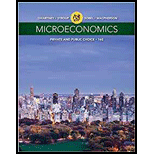
Distribution of income in United States.
Explanation of Solution
Income inequality is the unequal distribution of income or wages across various participants in an economy. During 2014, the families of lowest fifth category earned about 3.6 percent of income share. The highest fifth families earned 48.9, which is more than 14 times of that lowest fifth. While considering the income share after tax and in-kind government transfer benefits, the highest fifth category earned about 7.4 times of the lowest fifth category. That means, the inequality in the income reduced. The difference in income may occurs when there is difference in education, skill, talent and so on, which cannot be considered as unfair distribution of income. On the other hand, difference in wage,
Income inequality: Income inequality can be defined as the unequal distribution of income or wages across various participants in an economy.
Want to see more full solutions like this?
Chapter 15 Solutions
Microeconomics: Private and Public Choice (MindTap Course List)
- What is the difference between income and wealth? Which would you expect to have a more unequal distribution, and why? How might wealth impact income, and the distribution of income?arrow_forwardWhat is the solution to the income disparity between affluent and poor?arrow_forwardHow much age affects inequality? Is there something the government can do about younger and older people's incomes?arrow_forward
- Why is there an increase in poverty and inequality?arrow_forward(a) Suppose that your professor asks you to compare China and India based on income inequality. Which measure would you use and explain how would you determine which country is doing better based on the chosen measure? (b) Suppose that your professor asks you to compare China and India based on economic development. Which measure would you use and explain how would you determine which country is dbing better based on the chosen measure?arrow_forward
 Economics: Private and Public Choice (MindTap Cou...EconomicsISBN:9781305506725Author:James D. Gwartney, Richard L. Stroup, Russell S. Sobel, David A. MacphersonPublisher:Cengage Learning
Economics: Private and Public Choice (MindTap Cou...EconomicsISBN:9781305506725Author:James D. Gwartney, Richard L. Stroup, Russell S. Sobel, David A. MacphersonPublisher:Cengage Learning Microeconomics: Private and Public Choice (MindTa...EconomicsISBN:9781305506893Author:James D. Gwartney, Richard L. Stroup, Russell S. Sobel, David A. MacphersonPublisher:Cengage Learning
Microeconomics: Private and Public Choice (MindTa...EconomicsISBN:9781305506893Author:James D. Gwartney, Richard L. Stroup, Russell S. Sobel, David A. MacphersonPublisher:Cengage Learning
 Survey of Economics (MindTap Course List)EconomicsISBN:9781305260948Author:Irvin B. TuckerPublisher:Cengage Learning
Survey of Economics (MindTap Course List)EconomicsISBN:9781305260948Author:Irvin B. TuckerPublisher:Cengage Learning
 Economics (MindTap Course List)EconomicsISBN:9781337617383Author:Roger A. ArnoldPublisher:Cengage Learning
Economics (MindTap Course List)EconomicsISBN:9781337617383Author:Roger A. ArnoldPublisher:Cengage Learning





